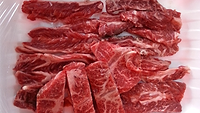Edible Sensor for Frozen Food Safety Indicates When Products Have Been Thawed, Refrozen

Credit: Adapted from ACS Sensors 2022, DOI: 10.1021/acssensors.2c0128
Researchers associated with the American Chemical Society (ACS), a nonprofit organization, recently developed a food-grade, edible sensor that can alert consumers to frozen products that have previously been thawed and refrozen. The sensor, made of safe ingredients such as table salt, red cabbage, and beeswax, provides a color readout when it is exposed to a specific temperature, which can be set from –58 F to 32 F.
Maintaining a certain temperature for frozen products is essential to food safety and quality. While researchers have previously developed devices that alert manufacturers when cold items are exposed to unwanted temperatures above freezing, the sensor designed by ACS is the first fully edible, self-powered temperature sensor with a visible color indicator for use with frozen products.
The researchers began by building a device that generated an electrical current as it defrosted, connecting magnesium and gold electrodes through an electrolyte solution held in a plastic container. The device was tested against solutions of frozen edible electrolytes, including table salt and calcium-containing salts, as well as naturally electrolyte-rich foods, including a grape, a melon, and an apple.
As the solutions defrosted, they conducted a current between –58 F and 32 F, which the researchers say can be fine-tuned based on the amount and identity of the salt. The device was then connected to a color-changing system, containing tin and gold electrodes and red cabbage juice, which produced an irreversible shift from reddish-purple to blue when the current was applied.
Finally, the research team combined the components of the device in a block of beeswax that contained the temperature-activated and indicator solutions in separate chambers, and demonstrated that the self-powered device could be used for frozen food monitoring. The researchers believe that their proof-of-concept sensor paves the way for edible materials to be used to create inexpensive, safe technology that can alert customers to a frozen product’s storage history.
The research was funded by the European Research Council, the EU Horizon 2020 program, and the Sustainability Activity of Istituto Italiano di Tecnologia. While ACS itself does not conduct chemical research, its Chemical Abstracts Service (CAS) division partners with global innovators to accelerate breakthroughs by curating, connecting, and analyzing scientific knowledge.
Looking for a reprint of this article?
From high-res PDFs to custom plaques, order your copy today!





